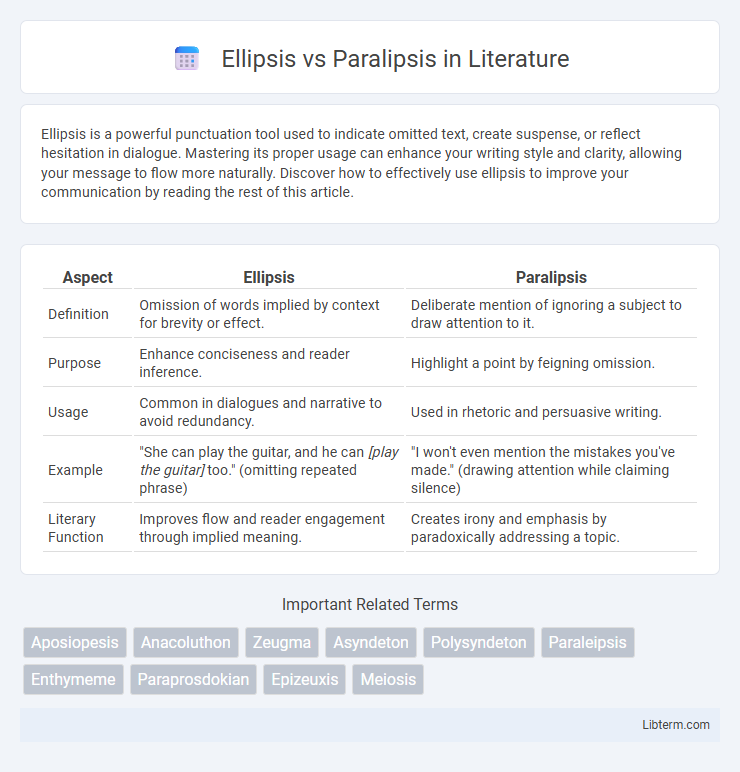Ellipsis is a powerful punctuation tool used to indicate omitted text, create suspense, or reflect hesitation in dialogue. Mastering its proper usage can enhance your writing style and clarity, allowing your message to flow more naturally. Discover how to effectively use ellipsis to improve your communication by reading the rest of this article.
Table of Comparison
| Aspect | Ellipsis | Paralipsis |
|---|---|---|
| Definition | Omission of words implied by context for brevity or effect. | Deliberate mention of ignoring a subject to draw attention to it. |
| Purpose | Enhance conciseness and reader inference. | Highlight a point by feigning omission. |
| Usage | Common in dialogues and narrative to avoid redundancy. | Used in rhetoric and persuasive writing. |
| Example | "She can play the guitar, and he can [play the guitar] too." (omitting repeated phrase) | "I won't even mention the mistakes you've made." (drawing attention while claiming silence) |
| Literary Function | Improves flow and reader engagement through implied meaning. | Creates irony and emphasis by paradoxically addressing a topic. |
Introduction: Understanding Ellipsis and Paralipsis
Ellipsis is a rhetorical device that involves the intentional omission of words or phrases to create concise and impactful statements, enhancing reader engagement through implied meaning. Paralipsis, a similar technique, explicitly mentions something by declaring its omission, thereby drawing attention to it indirectly and often used for ironic or emphatic effect. Both strategies manipulate sentence structure to influence audience perception and highlight essential information in discourse.
Defining Ellipsis: Meaning and Usage
Ellipsis is a linguistic device where part of a sentence is omitted because it is implied or understood from context, enhancing brevity and avoiding redundancy. This grammatical phenomenon often occurs in dialogue and coordinated sentences, allowing speakers or writers to convey meaning efficiently without repeating information. Ellipsis contrasts with paralipsis, which purposely omits mentioning something to draw attention to it indirectly.
Defining Paralipsis: Meaning and Application
Paralipsis is a rhetorical device where the speaker or writer brings up a subject by stating they will not mention it, often to emphasize the point indirectly. It operates by highlighting information through the pretense of omission, creating a persuasive effect in speeches and writing. This technique is frequently used in political discourse and literary works to subtly influence the audience while maintaining plausible deniability.
Key Differences Between Ellipsis and Paralipsis
Ellipsis involves the omission of words that are implied by the context, enhancing brevity and cohesiveness in sentences, while paralipsis is a rhetorical device where a speaker or writer deliberately mentions something by stating they will not mention it, often to emphasize a point subtly. Key differences lie in their functions: ellipsis reduces redundancy by leaving out unnecessary words, whereas paralipsis draws attention to a topic through strategic omission. Understanding these distinctions clarifies their unique roles in language and communication strategies.
Common Functions in Rhetoric and Literature
Ellipsis and paralipsis serve distinct rhetorical functions by emphasizing key information through omission. Ellipsis enhances narrative efficiency by deliberately leaving out words that are contextually understood, creating a concise and impactful expression. Paralipsis strategically claims to omit information while actually drawing attention to it, often used to underscore a point subtly or ironically in literature and speeches.
Ellipsis: Examples in Writing and Speech
Ellipsis is a linguistic device where part of a sentence is omitted because it is implied or understood from context, enhancing conciseness and fluidity in both writing and speech. Examples include "I ordered the pasta, and he the steak," where the verb "ordered" is omitted, and dialogue like "Want to go?" with the subject "you" left out. This technique allows for smoother communication by avoiding repetition and emphasizing key information.
Paralipsis: Examples in Texts and Dialogues
Paralipsis is a rhetorical device where the speaker or writer brings up a subject by explicitly stating they will not mention it, often to highlight or emphasize it indirectly. For example, in Shakespeare's "Julius Caesar," Mark Antony uses paralipsis when he says, "I will not say that Brutus is an honorable man," ironically casting doubt on Brutus's honor. In dialogues, paralipsis can create dramatic irony or sarcasm, as a character might say, "I won't even mention your past mistakes," drawing attention to those mistakes while pretending to ignore them.
How to Choose Between Ellipsis and Paralipsis
Choosing between ellipsis and paralipsis depends on the desired rhetorical effect and clarity. Ellipsis omits words or phrases that are easily inferred from context to create concise, fluid sentences, enhancing reader engagement without disrupting meaning. Paralipsis highlights a subject by stating that it will not be mentioned, often used for emphasis or irony, making it ideal when subtly drawing attention to sensitive or controversial points.
Impact on Reader Interpretation and Engagement
Ellipsis subtly omits parts of a sentence, prompting readers to infer missing information, which enhances engagement through active interpretation. Paralipsis explicitly mentions what is being omitted, creating irony or emphasis that guides reader attention and deepens understanding. Both techniques manipulate narrative focus and impact reader perception by balancing what is revealed and concealed.
Conclusion: Mastering Ellipsis and Paralipsis
Mastering ellipsis sharpens concise communication by omitting redundant words, enhancing clarity and reader engagement. Paralipsis strategically emphasizes points by feigning omission, enriching persuasive writing with subtlety and irony. Proficient use of both rhetorical devices elevates writing effectiveness, balancing brevity with nuanced emphasis.
Ellipsis Infographic

 libterm.com
libterm.com